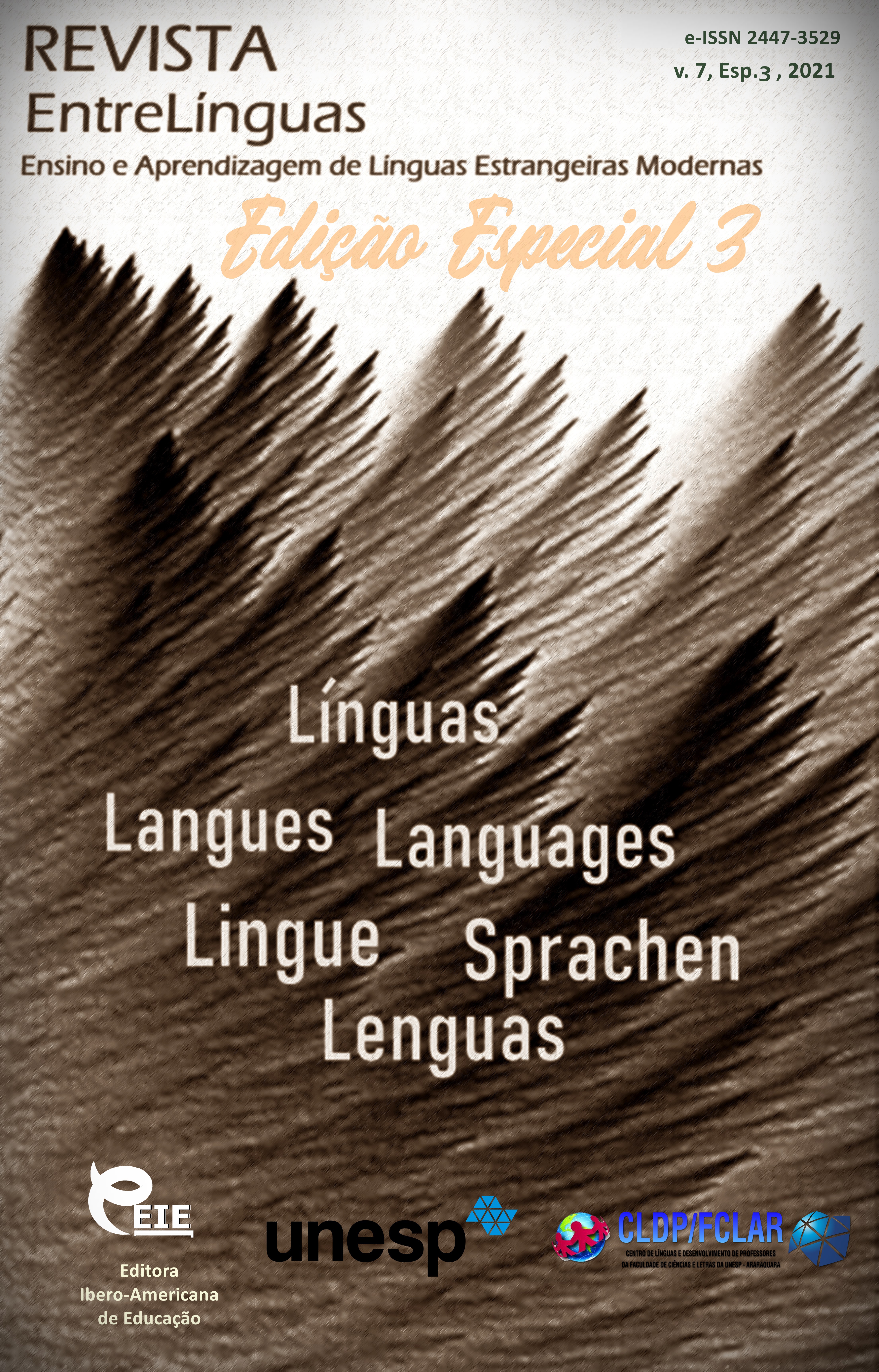English as a tool for cross-cultural communication
DOI:
https://doi.org/10.29051/el.v7iesp.3.15706Keywords:
Communication, Intercultural communication, Critical thinking, English as an international language, LinguisticsAbstract
The ability to speak one language is considered insufficient for successful career development. It is believed that speaking more than one language can deliver the economic growth of the country. Integration and globalization in education set new educational standards for future professionals. The study is relevant due to the significance of the English language in various spheres of activity. The development of the intercultural communicative competence is the main objective of educational institutions all over the world and international organizations such as the United Nations Educational, Scientific and Cultural Organization (UNESCO) and the Organization for Economic Co-operation and Development (OECD). English as an international language is considered by the author as a tool for cross-cultural communication. The main aim of the research work is to identify the concept of cross-cultural communication as a part of intercultural communication competence. The authors reveal potential challenges in language learning and give different approaches to successful language acquisition. The case study of the USA as one of the multi-ethnic countries in the world deserves examining. The system of education in the USA takes leading positions in the matter of modernization and reformation. Fundamental principals in learning English as a foreign language/ English as a second language reflect the well-organized system ensuring the development of tolerance, respect for the representatives of different ethnic groups, their cultures, beliefs and values, thus, providing efficient intercultural communication.
Downloads
References
ABDULLINA, L. R.; AGEEVA, A. V.; GABDREEVA. N. V. Using the Flipped classroom model in the teaching of the theoretical disciplines (French language) at the university. XLinguae, v. 12, n. 1XL, p. 161-169, 2019.
ABROSIMOVA, G. A.; KONDRATEVA. I. G. Strategies for effective foreign language perception. Kazan Linguistic Journal, v. 1, n. 4, p. 72-81, 2018.
BLUM, S. D. Language shock: understanding the culture of conversation. Journal of Linguistic Anthropology, v. 6, n. 1, p. 105-107, 1996.
BYRAM, M. Teaching-and-learning language-and-culture. Clevedon: Multilingual Matters, 1994.
BYRNES, H. The cultural turn in foreign language departments: challenges and opportunity. Profession, p. 114-129, 2002.
CUMMINS, M. W. GRIFFIN, R. A. Critical race theory and critical communication pedagogy: articulating pedagogy as an act of love from black male perspectives. Liminalities: A Journal of Performance Studies, v. 8, n. 5, p. 85-106, 2012.
DAMEN, L. Culture learning: the fifth demention in the language classroom. Reading, MA: Addison-Wesley Publishing Company, 1987.
FASSETT, D. L.; WARREN. J. T. Critical communication pedagogy. Thousand Oaks, CA: Sage, 2006.
FINEHAUER, E.; HOWARD. E. Attending to the third goal: cross-cultural competence and identity development in two-way immersion programs. Journal of Immersion and Content-Based Language Education, v. 2, n. 2, p. 257-272, 2014.
GAY, G. Culturally responsive teaching: theory, research and practice. 2. ed. New York: Teachers College Press, 2010.
HANLEY, J. Beyond the tip of the iceberg: Five stages toward cultural competence. Today’s Youth: The Community Circle of Caring Journal, v. 3, n. 2, p. 9-12, 1999.
HAYS, D. G. Assessing multicultural competence in counselor trainees: A review of instrumentation and future directions. Journal of Counseling and Development, v. 2, n. 1, p. 95-101, 2008.
HOOVER, J. J. et al. Methods for teaching cultural linguistically diverse exceptional learners. Newark, NJ: Pearson Education, 2008.
JACKSON, L. G.; GUZMAN, S. B.; RAMOS, G. Learning a borderland professional identity. Counterpoints, Teaching Bilingual/Bicultural Children: Teachers Talk about Language and Learning, v. 37, n. 1, p. 29-37, 2010.
KEARNEY, E. Intercultural learning in modern language education: expanding meaning-making potential. Bristol: Multilingual Matters, 2015. 216 p. DOI: doi.org/10.21832/9781783094684
MARTIN, J. N.; NAKAYAMA, T. K. thinking dialectically about culture and communication. Communication Theory, v. 9, n. 1, p. 125, 1999.
MATSUDA, A. Preparing teachers to teach english as an international language. Bristol: Multilingual Matters, 2017. 256 p. DOI: doi.org/10.21832/9781783097036
SABIROVA, D. R. et al. Comprehension of the English National Character in Building Professional Linguistic Culture. Journal of Educational and Social Research, v. 9, n. 3, p. 101-106, 2019.
SABIROVA, D. R.; KHANIPOVA. R. R. Innovative approaches to teaching and learning English as second and English as foreign language in multilingual education. Humanities & Social Sciences Reviews, v. 7, n. 6, p. 45-48, 2019.
SOBRÉ-DENTON, M. S.; BARDHAN. N. Cultivating cosmopolitanism for intercultural communication: communicating as a global citizen. London: Routledge, 2013.
SORRELLS, K. Intercultural communication: globalization and social justice. Los Angeles, CA: Sage, 2013.
SWAFFER, J.; ARENS. K. Remapping the foreign language curriculum: an approach through multiple literacies. New York, NY: Modern Language Association, 2005.
TATUM, B. Why are all the black kids sitting together in the cafeteria? New York, NY: Basic Books, 1997.
WEAVER, G. R. Understanding and coping with cross-cultural adjustment stress. Cross-cultural orientation. New conceptualizations and applications. Lanham, MD: University Press of America, 1986.
Published
How to Cite
Issue
Section
License

This work is licensed under a Creative Commons Attribution-NonCommercial-ShareAlike 4.0 International License.
Os manuscritos aceitos e publicados são de propriedade da Revista EntreLínguas. Os artigos publicados e as referências citadas na Revista EntreLínguas são de inteira responsabilidade de seus autores.
Transferência de direitos autorais – autorização para publicação
Caso o artigo submetido seja aprovado para publicação, já fica acordado que o(s) autor(es) autoriza(m) a UNESP a reproduzi-lo e publicá-lo na EntreLínguas, entendendo-se os termos “reprodução” e “publicação” conforme definição respectivamente dos incisos VI e I do artigo 5° da Lei 9610/98. O artigo poderá ser acessado pela rede mundial de computadores (Internet), sendo permitidas, a título gratuito, a consulta e a reprodução de exemplar do artigo para uso próprio de quem a consulta, desde que haja a citação ao texto consultado. Essa autorização de publicação 328 EntreLínguas, Araraquara, v. 1, n .2, p. 323-328, jul./dez. 2015 não tem limitação de tempo, ficando a UNESP responsável pela manutenção da identificação do(s) autor(es) do artigo. Os artigos publicados e as referências citadas na Revista EntreLínguas são de inteira responsabilidade de seus autores.











